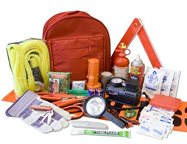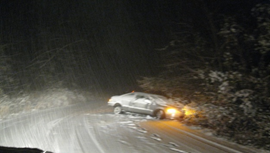恶劣天气在一年中的任何时候都可能发生.
Click here to view the UNH Weather Emergency Action Plan
冬季天气准备
A winter storm 在新罕布什尔州 can range from a moderate snowfall over a few hours to a Nor’easter, bringing blizzard conditions with blinding wind-driven snow that lasts several days. People can become stranded in their automobiles or trapped at home, 没有公用设施或其他服务. The aftermath of a winter storm can have an impact on a community or the entire region for days, 几周甚至几个月. 风暴的影响, 在新罕布什尔州, 包括大量积雪, 极端低温, 重, 树木和电线上的湿雪或结冰, 高速公路封闭,道路堵塞, 屋顶倒塌, 海岸洪水和海滩侵蚀.
House fires and carbon monoxide poisoning occur more frequently in the winter due to lack of proper safety precautions when using alternate heating sources, 比如无人看管的火灾和取暖器. 对于大多数潜在的灾难:做好准备, monitoring the media and common sense can minimize the danger to you and your family.
在冬季风暴来临之前
了解天气预报员使用的术语:
冬季风暴观察-保持警惕,你所在地区可能会有一场冬季风暴. 请收听广播或电视以获取更多信息.
冬季风暴警告-采取行动,风暴正在或正在进入该地区.
暴雪预警– Snow and strong winds combined will produce blinding snow, 接近零能见度, 深飘, 还有危及生命的风寒. 立即寻求庇护.
冬季天气预报– Winter weather conditions are expected to cause significant inconveniences and may be hazardous, 尤其是对开车的人.
冻雨-落到地上就结冰的雨, 在路面上结了一层冰, 人行道, 树木和电线. If a ½ inch or more of freezing rain is forecast an Ice Storm Warning will be issued.
风寒警告/警告– Combination of wind and cold resulting in temperatures that feel -15F
- 有一个 应急供应包 靠自己至少活三天.
- 不易腐烂的食品,
- 瓶装水,手电筒和备用电池
- 一个便携式收音机,以防停电
- Additional items that should be included are a freshly-stocked first-aid kit, 基本处方药, 非电动开罐器, 婴幼儿护理产品, 额外的毯子, sleeping bags and a fire extinguisher and do not forget about your pet’s needs.
- To stay warm have 额外的毯子 or sleeping bags available. 多穿几层衣服.
- Keep fire extinguishers on hand and make sure everyone knows how to use them.
- 开发一个 家庭紧急通讯计划 in case family members are separated from one another during a winter storm (a real possibility during the day when adults are at work and children are at school or attending college), 还有一个复合的计划. Ask an out-of-state relative or friend to serve as the ‘family contact’. After a disaster, it is often easier to call long distance. Make sure everyone knows the name, address and telephone number of the contact person.
- 拥有房屋的教职员工和学生:
- Have sufficient heating fuel, as regular sources may be cut off. Have emergency heating equipment and fuel (gas fireplace, wood burning stove or fireplace) so you can keep at least one room livable. 确保房间通风良好.
- 如果没有自动燃料输送计划,启动一个. 与燃料供应商一起制定付款计划
- Make sure your home/apartment is equipped with working smoke detectors and carbon monoxide alarms with battery back-up.
- 确保你的房子绝缘. Caulk and weather-strip doors and windows to keep cold air out.
- To keep pipes from freezing, let faucets drip a little to avoid freezing. 知道如何关闭水阀.
- 如果管道结冰, 去除绝缘, completely open all faucets and pour hot water over the pipes, 从最寒冷的地方开始. A hand-held hair dryer, used with caution, also works well.


汽车安全提示
- Keep your gas tank full and check your windshield wiper fluid.
- 安装有足够胎面的冬季轮胎. Ensure your vehicle is maintained and in good working order.
- Keep a windshield scraper, small broom and shovel for ice and snow removal
- 仔细计划长途旅行, listening to the radio or television for the latest weather forecasts and road conditions. If bad weather is forecast, drive only if absolutely necessary.
- 建议的项目 冬季急救车包 准备一个有备用电池的手电筒, 一个基本的急救箱, 必要的药物, 小刀, 助推器电缆或跳跃套件, 毯子或睡袋, 额外衣物(包括雨具), 连指手套和袜子), 不易腐烂易打开的食品, 产生车辆牵引力的沙子, 轮胎链条或牵引垫, 基本工具箱(钳子), 扳手, 螺丝刀), 拖绳, a container of water and a brightly colored cloth to serve as a flag, 如果有必要的话.
- 白天出行, 让别人知道你的日程安排, 路线,如果可能的话, 带另一个人一起去. Stay on main roads; avoid back road shortcuts.
- If a blizzard traps you in your car, pull off the highway. Turn on hazard lights and hang a distress flag from your radio antenna or window.
- Remain in your vehicle where rescuers are more likely to find you. Do not set out on foot, unless you can see a building close by where you know you can take shelter.
- Run the engine and heater about 10 minutes each hour to keep warm. When the engine is running, open the window slightly for ventilation. 定期清除排气管中的积雪.
- 运动以保持体温,但避免过度运动. 在严寒中,与乘客挤在一起.
- 轮流睡觉. One person should be awake at all times to look for rescue crews.
- 多喝水以避免脱水.
- 注意不要浪费电池电量. Balance electricity energy needs: the use of lights, heat and radio. At night, turn on the inside light so work crews and rescuers can see you.
在冬季风暴中
Stay indoors and limit travel to only absolutely necessary trips.
- 如果你需要去户外, 应季着装, 穿好几层宽松的衣服, 轻量级, 温暖的衣服, 而不是一层厚重的衣服. The outer garments should be tightly woven and water repellent.
- 连指手套比普通手套好.
- Wear a hat; most body heat is lost through the top of the head.
- 用围巾遮住嘴,保护肺部.
- 铲雪时要小心. Over-exertion can bring on a heart attack – a major cause of death in the winter.
- Watch for signs of frostbite: loss of feeling and white or pale appearance in the extremities such as fingers, 脚趾, 耳垂或鼻尖. 如果发现症状,请立即寻求医疗帮助.
- Watch for signs of hypothermia: uncontrollable shivering, 记忆丧失, 定向障碍, 不连贯, 口齿不清, 困倦和明显的疲惫. 如果检测到症状, 把受害者转移到温暖的地方, 脱掉任何湿衣服, 先温暖身体的中心,并给予温暖, 不含酒精的饮料, 如果受害者是有意识的. 尽快寻求医疗帮助.
冬季风暴过后
- Stay off roads to allow plowing operations to proceed smoothly.
- Help dig out fire hydrants and storm drains in your neighborhood.
- Avoid parking too close to corners, allowing Public Safety vehicles and plows to maneuver safely.
- 注意孩子们在街上玩耍, particularly climbing on or running out from behind large snowdrifts.
- Parents should remind their children to be aware of plowing operations and traffic.
- Never run automobile until exhaust pipe has been cleared of snow.
- Home owners, make sure backup generators and alternative heating sources are well ventilated
- 慢慢铲吧. 避免过度运动.
- 小心掉落的电线. 假设一条向下的电线是一条带电的电线. 向当局报告.
- Watch out for overhead hazards such as broken tree limbs and ice on roofs and wires.
- Home owners, make sure backup generators and alternative heating sources are well ventilated.
- Remove 重 snow from roofs; if safe to do so. 确保排水沟和排水沟畅通.
- Home owners, make sure backup generators and alternative heating sources are well ventilated.
其他冬季天气准备资料:
Special Thanks to Boston College Office of 应急管理
